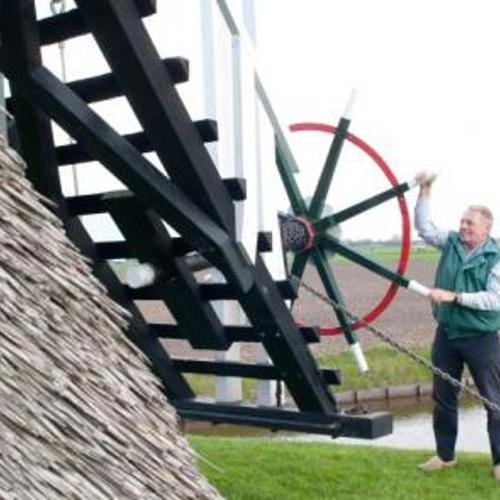
If the blades are turning, the mill is open
If the blades are turning, the mill is open
A picture postcard
The Kalkmolen glistens pretty as a picture in the sun. The upper house is painted red, the zinc roof has weathered white and the brown sails on the blades make the the windmill, which is in itself fairly small, appear grand. The wooden hut around the water wheel is shining from the newly affixed tar layer. The grass on the islet is neatly mown and the thatched roof on the roundhouse of the windmill radiates authenticity. Nevertheless, the windmill is not just decorative. It has an important function: together with the adjacent Doesmolen, which looks exactly the same, the Kalkmolen keeps the Doespolder dry. ‘The Doesmolen has been here for a much longer time, but because it is on peat, the ground subsided. However, the Doesmolen stayed at the same height, so that at a certain point in time the scoop wheel came to lie above the water. A decision was then made to locate the Kalkmolen here to propel the water up and to make the Doesmolen fully functional again.’
Relocated
The new location of the Kalkmolen was the salvation of the 1684 architecture. The windmill had almost completely disappeared. In 1959 an electric pumping station took over the windmill's drainage task, which at that time was still situated in Leiderdorp to make the Kalkpolder dry. The Kalkpolder was closed in 1972. The windmill continued to deteriorate and finally in 2006 was taken apart in pieces and transported to a work place, where it faced an uncertain future. Because the Doesmolen was having problems with the drainage of the Doespolder, the Kalkmolen was restored and placed next to the Doesmoeln in 2009.
Freedom
Wednesday and Saturday are the fixed workdays of miller Driesprong, but he is there far more often. ‘The freedom I have here is pure joy. There is always something to do; mowing the grass, painting or cleaning. In the spring everything has to be coated with tar and in the autumn I repeat this for the exposed parts. Sometimes I go into the upper house to remove cobwebs. If there is a period of little rain, the windmill has to turn every now and again so that the wood doesn’t not rot.’ If there does not happen to be any work, Driesprong grabs a book, takes a boat out onto the Does or makes coffee in his cosy living room. This small room is behind the wheel that operates the water wheel outside. ‘A whole family used to live here.’ This is hard to imagine when you see the size of the room.
Turning into the wind
In addition to his fixed workdays it is Driesprong's task to assist when called upon by the Hoogheemraadschap (the regional water board). ‘If a lot of rain and wind is predicted, they ask if we want to help. When the weather's like that there is a big chance that the pumps which do the pumping work on normal days, cannot handle it. My fellow miller of the Doesmolen and I operate the mill in the wind by manually turning the blades into the wind, put the sails on and deal with the excess water by pumping it upward to the Does. From there it flows off to the Old Rhine. This prevents the farmers' meadows from becoming flooded.’ Driesprong shows us the turning mechanism. He loosens the iron chains which are fastened to the capstan wheel which drives the tail-pole. This turns the upper house with the windshaft until the blades are turned to the wind.
Over 400,000 revolutions
Driesprong keeps track of the revolutions in a logbook; a revolution means the full circle of all four blades. ‘Last year was a busy year. The windmills made a total of 402,500 revolutions. July and August in particular were very wet; October also stood out. The windmill turns up to a maximum of windforce 7, otherwise the system cannot handle it. That the wind is strong is apparent when viewing the crown wheel in the upper house,the wind slightly swells. The whole house shakes. ‘And this is only windforce 3.’









